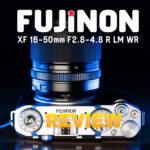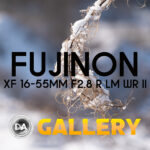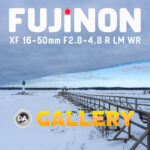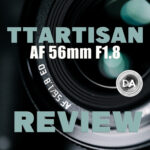
It’s been nearly 5 years since I’ve done my review of the Fujinon XF 56mm F1.2 R lens, which was regarded as one of the classic portrait options due to its large maximum aperture (F1.2) and classic 85mm equivalent angle of view (56mm x Fuji’s 1.5x crop factor = 84mm). My conclusion was that while the lens had some nice optics (more in the overall rendering rather than great sharpness at large apertures), the clunky focus motor, lack of weather sealing, and high price ($999 USD) left me somewhat underwhelmed. My conclusion was that this lens was only competitive on Fuji only because (at the time) Fuji was a closed platform, and Fuji XF shooters didn’t really have options. Thankfully, that is no longer true, as since that time Fuji has opened up their platform to alternatives, and at this point you can get half a dozen 56mm autofocusing third party lenses in X-mount, including two from Viltrox (56mm F1.4 reviewed here and newer 56mm F1.7 reviewed here), TTArtisan (AF 56mm F1.8, reviewed here), Sigma (56mm F1.4, reviewed here on Sony), Sirui, (Sniper 56mm F1.2, reviewed here), and one from Tokina (56mm F1.4) that I haven’t reviewed. Add the two Fuji options, and you’ve definitely got options. Fuji now has to compete on merit, and the new Fujinon XF 56mm F1.2 R WR has a lot of merits…but also still have a few flaws.
Follow Me @ YouTube | Patreon | Instagram | Facebook | DA Merchandise | Flickr | 500px | X
Thanks to Fujifilm Canada for sending me a review copy of this lens. As always, this is a completely independent review. All opinions and conclusions are my own. I’m doing this review on a 40MP Fujifilm X-H2 camera.
__________________________________________________________________________________________________
The plethora of new 56mm options show how important this focal length is as a portrait lens and short telephoto general purpose lens. 85-100mm is my favorite portrait range, and having that massive F1.2 aperture really allows for beautiful background separation even when shooting fuller length portraits. As we’ll see in this review, the Fuji 56mm WR remains the premium priced lens in the comparison. It’s full retail is $999 USD (as before), though the lens is currently on sale for $899 (at the time of this review) on a sale price. That’s more than double the price of any of competing lenses on the platform. But in some ways the price tag, while high, feels a little more justified this time around, as this is genuinely the premium option among the many alternatives that I’ve reviewed. It still has some flaws, but its ability to really perform at F1.2 for portrait work makes it special.

There have been some really competitive lenses recently release with smaller maximum apertures (the TTArtisan AF 56mm F1.8 and the Viltrox AF 56mm F1.7 are the standouts due to being both strong performers AND costing less than $160 USD!), but neither one of them can provide the kind of subject separation that the Fuji and its F1.2 aperture can.
Here’s an example: with both lenses stopped down to F2, I felt the Viltrox F1.7 lens did a shockingly good job of providing similar sharpness and contrast for portrait work.

But where the 56mm WR showed the clear advantage is if you look at the backgrounds. Look at how much creamier the background is from the Fuji (on the right).

The difference would be even more pronounced if the subject was closer to the background.
There are two ways to view this:
- “A lens like the Sigma 56mm F1.4 is close enough at half the price. The Fuji isn’t worth the premium.”
- “Like a performance car, you pay for that last little extra bit of performance, but that can be the different between winning and losing.”
I think both perspectives are valid. Where I have an issue is when something has both a premium price and a less than premium performance (which is what I felt about the previous 56mm F1.2 from Fuji), but in this case I do think this is a premium lens in the class on X-mount. Let me put another way: in 2019 I sent the XF 56mm F1.2 R back after my loaner period without a moment’s regret; with the XF 56mm F1.2 WR I’m scheming of a way to add one to my own kit.

Sound interesting? Let’s break things down in detail…
Build and Handling
One of the key areas that needed improvement has been addressed…and it shows up right there in the name. This is Fujinon XF 56mm F1.2 R WR has both R (Aperture Ring) and WR (Weather Resistance) in the name. The weather resistance was definitely needed on a premium lens, and it does provide an area where this lens is set apart from most of of the other available lens. Fuji has chosen to not give their new lenses a MK II designation, which in my mind is a mistake as it makes it less apparent that Fuji has a new and improved 56mm F1.2 on the market. I’ll refer to this one as the 56mm WR throughout the review to distinguish it from the older, non WR lens.

That weather sealing takes the form of a gasket at the lens mount along with internal seals (Fuji cites 9 seal points plus a fluorine coating on the front element to resist oil and moisture). This is very handy as you can continue to use the lens with confidence even when the weather turns a bit sour (providing you are shooting on a weather sealed camera).

As noted, the XF 56mm WR has the largest maximum aperture of the competitors save the Sirui Sniper AF 56mm F1.2. As such, it is larger and heavier than most of the competitors, though the Sirui is actually slightly larger (72mm x 92.2mm, since this comparison chart doesn’t show its dimensions).

The Sirui lens is longer and slimmer, while the Fuji has that squat prime look that frankly looks pretty sweet mounted on a camera.

If you compare it to the recent Viltrox F1.7 and TTArtisan F1.8 lenses, the Fuji looks a bit hulking.

But compare it to the X-mount version of the Viltrox Pro AF 75mm F1.2 (the most worthy competitor even if the focal lengths aren’t identical), and the Fuji looks positively svelte.

Fuji’s design language hasn’t really changed much over the years, so the look of this lens isn’t radically different, though the shape is a little more sculpted. It’s a nice looking lens, however, with just a little more gloss that speaks of it being a newer design. Unfortunately Fuji’s feature list hasn’t really really expanded since the release of the original lens in 2014. We have an aperture ring on the barrel…and not much else.

That’s a little disappointing, as while Fuji’s cameras have developed a lot of additional video specs during that period, there is absolutely no video related progress in their lens design. The aperture ring is clicked (one-third stop detents), but there is no option to declick the aperture to allow for aperture racking. No custom button that could be used for various functions, or even to program an A-B focus pull that some lenses allow.

There are no switches on the lens barrel. Fuji chose long ago to have switching between auto and manual focus through the camera (typically via a dedicated lever or button), so that means no AF/MF switch on the barrel. The lens feels nice, but for the prices that Fuji charges for these premium lenses, some updated features feel warranted.


The included lens hood is pretty huge…about 2/3rds the length of the lens.
This is the first Fuji X-mount lens to have a higher-than-blades aperture, and they have given this aperture iris eleven blades, which does a great job of keeping a circular shape even when the lens is stopped down (here at F5.6, nearly four stops closed).

That’s fantastic, as while there is some geometric deformation of specular highlights near the corners (lemon shape) at F1.2, in this series at F2 and F2.8 you can see that the specular highlights of the raindrops are nicely circular.



The filter threads have slightly grown to 67mm rather than 62mm, which is a bummer if you own the previous lens and are upgrading, but is a positive for everyone else, as 67mm filters are FAR more common than 62mm filters.

The manual focus ring is nice and wide and feels good in terms of damping, though manual focus emulation here isn’t great. Mirrorless lenses utilize a focus-by-wire system where input on the focus ring is routed through the focus motor. Because this lens does not have the smoothest focus motor, you can really feel the pulses of the focus motor with every little adjustment you make. The slightly noise and rough pulses of the focus motor really pull you out of the manual focus experience…which takes away from the otherwise quality feel of the manual focus ring. The active focus area will be automatically magnified when you start to focus.

It’s a bit sad, but the budget TTArtisan AF 56mm F1.8 actually provides a much more sophisticated feeling manual focus experience.
Another key area of improvement by Fuji over the original 56mm F1.2 is when it comes to minimum focus distance. The original lens had the kind of minimum focus distance typically reserved for a much longer focal length, only able to focus as closely as 70cm and provided a very low 0.9x magnification. The newer 56mm WR can focus closer (50cm) despite having a longer focal length, which adds up to a much improved magnification of 0.14x, which is vastly more useful for up close work for both photos and video.

Not only that, but the up close performance is very strong even at F1.2, with great sharpness and contrast even on my very high resolution X-H2. Here is a shot at MFD and F1.2, and notice how clean the details are when deeply cropped.


Other than a less than desirable manual focus experience and a lack of evolution on the feature set, this is another nicely built Fuji lens, and at least we got the important upgrades of weather sealing and a much more usable up close experience.
Autofocus and Video
Uggg. This is rarely a very enjoyable section for me when reviewing anything on Fuji. With every new Fuji camera we hear about how improved autofocus is (and it is, to some degree), but it just never seems to actually get to the level of the competition. Even cheap lenses on Sony tend to autofocus better than the best lenses on Fuji, but unfortunately I can’t divorce lens performance from the camera’s autofocus…and I’m testing using one of Fuji’s very best cameras.
Furthermore, Fuji can’t seem to find a way to put their superior linear motors in their larger aperture lenses. That means we are saddled with a DC style motor here as in the 50mm F1.0. And while I have read some reviews that brag that this motor is just fine…these people are either being disingenuous or aren’t aware of what is available on other platforms. Autofocus performance is adequate at best, and rather crude in the process. This is not a refined focus motor, making all kinds of whirs and clunks as it goes about its business. I often have to put my ear right up next to the lens to try to hear any focus noise when doing autofocus tests, but that was definitely not necessary here. I could hear them every time I shot, even when using the lens at waist height and viewing in a field monitor.

Focus precision was generally good, but the focus process is slowed because there will often be a double clutch where the focus motor will first move to the approximate focus point and then do a secondary adjustment to refine focus. That slows focus speed down, and the fact that the focus motor makes noise during both steps draws your attention to it.
At the same, I found that focus was very reliable for work during portrait sessions. Focus is nailed even at F1.2:


I loved this lens as a portrait lens, as while I may not love the smoothness of the autofocus system, it did deliver well focused results in a variety of settings…and the optics are lovely!






I even took a few portraits of this gator, which did not impress my wife, as it was just sunning itself along a pond and I got rather close to take my series of photos.

I eventually scared him, and fortunately he chose to jump into the water rather than jumping the photographer!
While I wouldn’t recommend this lens as a sports lens, I did find that once I grabbed hold of a group of gulls nearby me on the beach, I was able to stay pretty sticky on them even shooting at F1.4:

Here’s another example of pinpoint focus of a static object at F1.2:

Point being that while the focus is not very sophisticated in feel, this is an improved AF system over the previous generation in speed, and, more obviously, accuracy.
Video AF is even sorer spot with me on Fuji. There tends to be more obvious steps in video pulls, the touchscreen is often unresponsive in trying to force autofocus changes, and tracking isn’t as sophisticated. Fuji has clearly tried to detune focus speed a bit here to quiet the focus motor and smooth the process when the microphone will be recording, but the results are pretty mixed. There’s less focus noise due to the slowed focus speed, though the on board microphone did still pick up a bit of focus sound. Focus transitions are on the slow side, and there is a very obvious step where focus travels 3/4ths of the way, pauses for a split second, and then makes a secondary focus pull to the final destination. There will often be some final microadjustments as focus attempts to settle on accurate focus lock.
This impacted the results of my hand test (where I alternately block and then unblock the camera’s view of my face with my hand) as well. I tried to give the camera extra time to make the transitions from my hand to my eye, but because of that double clutch of focus, the camera/lens would often complete the first of the two major focus pulls, but would pause…and by the time my hand was added or removed, it wouldn’t have quite made the transition. It would eventually get to my hand or my eye, but I had to be very patient.
On the plus side, focus breathing isn’t terrible, and, unlike the older lenses, at least focus would stay stable when I used the lens for static shots. There wasn’t the pulsing I saw on the 16-55mm and 18-55mm lenses I used side by side with it.
I’m not sure that I could recommend this lens for video work if you need autofocus…but I don’t really know a lens that I would strongly recommend over it. This is just an area where Fuji needs to improve, period. It’s frustrating because this lens is so good in so many other ways!
To offset the negativity, let me end with another positive. I found that autofocus continued to be precise even in very low light conditions. This shot of my son is at ISO 1600, F1.2, and with just a 1/90th second shutter speed. If I had been shooting with an F2.8 lens, that would have been a 1/10th second shutter speed. In other words, very dim lighting, and focus didn’t slow down much and remained accurate on his eye.

I would have loved to see a more refined focus motor here, but at least focus precision was good in my tests even if the focus process left somewhat to be desired…much like my feelings on the XF 50mm F1.0.
Image Quality Breakdown
Expect this section to go much more smoothly! There will be as many raves in this section as there were rants in the last. I traveled with the XF 56mm F1.2 WR alongside two of the venerable zooms (16-55mm F2.8 and 18-55mm F2.8-4 OIS), and the images from the newer lens just sparkled in comparison to those older lenses. This is one of those rare lenses that just sings on the new ultra high resolution 40MP X-Trans sensor (similar pixel density to over 90MP on a full frame sensor).

The optical formula is 13 elements in 8 groups, with two of those being aspherical elements and one being an extra low dispersion element. You can see just how impressively sharp the lens is across the rule of thirds portion of the frame in the MTF chart, with some drop-off to the corners. For perspective, I’ve added the MTF for the recent TTArtisans AF 56mm F1.8…and that MTF is 30lpmm rather than the much higher 45lpmm results shown in the Fuji chart.


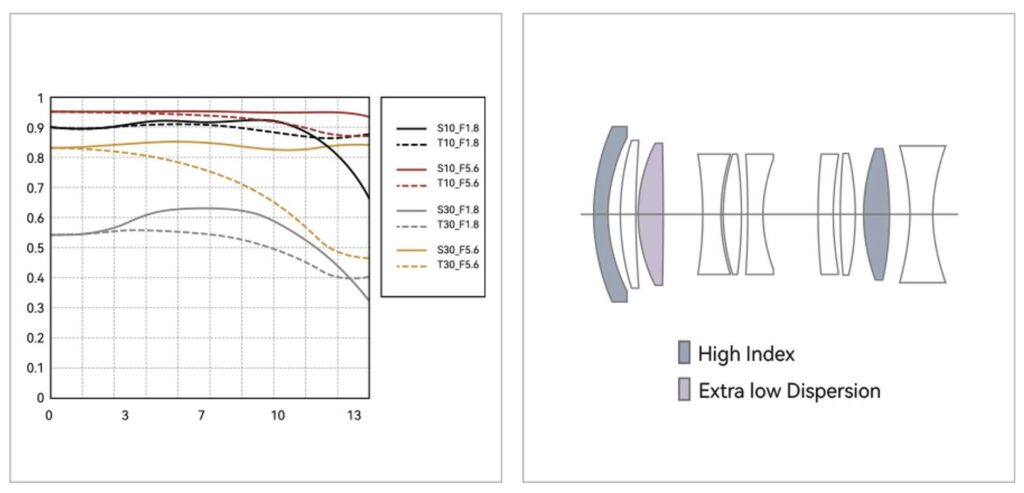
When the original 56mm F1.2 R was released, the Fuji standard resolution was 16MP, so I already saw the cracks when I tested it on 26MP. It just wasn’t very sharp before F2. The new lens is clearly designed with 40MP in mind; it is beautifully sharp even at F1.2 and has flawless contrast.


We’ll break down the details together. First of all, let’s look at vignette and distortion. There’s not much to see on either front.

I used a -1 to correct the tiniest amount of distortion and a +40 (just a little over a stop) to correct the vignette. That’s impressive for an F1.2 lens, and it shows how the slightly growth of the diameter of the lens had paid optical dividends.
Longitudinal chromatic aberrations were definitely an issue at times with the first generation lens, but Fuji has utterly slain LoCA here. I found lens markings to be an extreme torture test for LoCA, but I just don’t see fringing here.

I’ve got a fallen pine in the forest behind my house that lichen is growing on, and I find this lichen to be just miserable for many lenses for fringing. The 56mm WR just nails it, though, delivering instead gorgeous microcontrast on all of the various textures there.


Lateral chromatic aberrations show up near the edge of the frame in transitions from dark to light areas. You can see from the edge of my test chart Fuji has also nailed this metric, and there is next to no fringing in the transitions from black to white.

All of this is a huge improvement over the previous generation lens…and this is while reviewing the new lens on the much higher resolution sensor.
So how about resolution? The 40MP Fuji X-Trans sensor tends to make all but the very sharpest of lenses look a little soft when viewed at high magnification levels, and it just so happens that my review standard is to examine results at a 200% magnification. That is a lot to ask of any lens, but this is one that’s definitely up to the task. Here’s a look at the test chart that crops throughout the review come from:

And here is a look at F1.2 crops from the center, then mid-frame, and then extreme lower right corner:



Lovely. That’s great sharpness for an F1.2 lens. If you need to know what this sensor does to a lessor lens, check out how that performance compares to the Sirui Sniper 56mm F1.2 that I reviewed five months ago!

Ouch.
I typically don’t compare lenses to the Viltrox Pro AF 75mm F1.2 as it feels almost punitive; the Viltrox is just so much sharper than just about any lens I compare to it on Fuji. The 56mm WR is up to the challenge, though providing near identical levels of sharpness and contrast in the center of the frame.

If we move off to the corners, I actually prefer the Fuji save the last tiny bit on the edge where the Viltrox stages a comeback.

Yup. This is a very, very good lens optically.
And it is no paper tiger, either. I found sharpness held up even at greater distances and in harsher lighting conditions. Here’s an F1.2 shot at distance, and you can see from the crop that though the mid-day sun is bright on my wife, the lens has still delivered lovely contrast.


And look at how gorgeous the defocused region is. I shot this at Middleton Place in Charleston, South Carolina (a truly gorgeous place). Impressive.
It was great at night, too, delivering high detail even at F1.2 (ISO 1600 here) and with a lot of bright contrast transitions in this shot.


It was a lens that I didn’t hesitate to use even at F1.2 for portrait work. There’s plenty of detail and contrast, and it allows me to get great separation of my subject from the background.


Stopping down to F1.4 provides a slight boost to contrast, and by F2 the improvement is more pronounced. You can see that even the corners look pretty great by F2:

And remember, that’s on a 40MP body and showing the results at 200%. That’s impressively good.
The lens that I tested also showed good centering with a consistent performance in all four corners.
F2.8 is largely the same as F2, with just a slight bit more contrast at F4 and F5.6.
As you might expect, landscape results are just stunning, with great detail all across the frame along with Fuji’s excellent color in their optical glass.



Diffraction comes early on a high resolution body like this, so expect some softening by F11 and much more obvious softening by F16, which is minimum aperture here.

This is one of Fuji’s strongest performers optically. It really is a treat, as lenses like this make the 40MP sensor make sense. It just punishes the weaker glass.
I love walking around with a lens like this, as the large maximum aperture makes it easy to create storytelling images by isolating subjects.

The lovely bokeh augmented by great contrast makes it easy to shoot images like this where the eye is drawn through the layers of defocus towards the subject.

Shooting ordinary objects with a lens like this allows them to really stand out from otherwise distracting backgrounds, even when those backgrounds are close.

Get close to a subject and you can really blur out a background into a nice creamy mass of colors.

None of the competing 56mm lenses are going to be able to do this in quite the same way.
I was also able to get results even when shooting into the sun or other bright lights. Some of the cheaper lenses at this focal length I’ve tested really fall apart with bright lights in the frame, but that’s not the case here.

In short, there is basically nothing that I have to complain about here optically. This is a wonderful example of how to do lens design, with optics that deliver both high contrast and resolution while also giving lovely bokeh. Kudos to Fuji! You can check out the image gallery if you’d like to see more.
Conclusion
Lenses like the Fujinon XF 56mm F1.2 R WR give me hope that Fuji can make this 40MP sensor work. It is pretty tough on even good lenses, so it takes exceptional lenses like this to really sparkle on this sensor. But this lens does, and I could SEE the difference in the images from the new lens even when I was looking at a group of images without the lens designation showing. They just sparkled in a way that images from some of the older Fuji lenses I was shooting with did not.

I’m underwhelmed by the autofocus performance here (particularly for video), as it feels like Fuji has saddled these amazing optics with a decade old focus system. But even the somewhat clunky autofocus motor is incapable of souring me on this lens. The optics are too nice, and the size is still reasonable enough that I could happily haul it around all day. The improved minimum focus distance is also greatly appreciated, as it opens up new subject opportunites.

This is a lens that definitely goes onto my short list of lenses fully capable of handling the 40MP sensor of cameras like the X-T5 or X-H2. So if you own the older 56mm F1.2 R lens and are considering upgrading your camera, I do think this is a worthy upgrade for a lot of reasons. If you’ve recently upgraded to one of the 40MP Fuji bodies, this lens should definitely be on your short list of lenses worth buying. At $900 USD (at the moment), this lens isn’t cheap, but it is also pretty special. And sometimes special is worth paying for.

Pros:
- Nicely built lens
- Nice looking lens
- Full weather sealing and fluorine coating
- Focus accuracy good
- No distortion
- Well controlled vignette
- Low chromatic aberrations
- Awesome sharpness across the frame even at F1.2
- One of the sharpest lenses on Fuji when stopped down
- Much improved minimum focus distance and up close performance
- Handles high contrast scenes great
- Lovely bokeh
- Better flare resistance
Cons:
- Focus experience feels dated already
- Manual focus experience flawed by the focus motor sounds and vibrations
- No progress of lens features in the past decade
_________________________________________________________________________
GEAR USED:
Purchase the Fuji 56mm F1.2 WR @ B&H Photo | Adorama | Nuzira | Amazon | Camera Canada | Amazon Canada | Amazon UK | Amazon Germany
Purchase the TTArtisan AF 56mm F1.8 @ B&H Photo | Adorama | Amazon | Amazon Canada | Amazon UK | Amazon Germany
_____________________________________________________________
Purchase the Fujifilm X-H2 @ B&H Photo | Adorama | Amazon | Camera Canada | Amazon Canada | Amazon UK | Amazon Germany
_______________________________________________________________
Purchase the Fujifilm X-T5 @ B&H Photo | Amazon | Camera Canada | Amazon Canada | Amazon UK | Find it Used at KEH
________________________________________________________________
Purchase the Fujifilm X-S20 @ B&H Photo | Adorama | Amazon | Camera Canada | Amazon Canada | Amazon UK | Amazon Germany |
_________________________________________________________________
Want to support this channel? Use these affiliate links to shop at: B&H Photo | Amazon | Adorama | Camera Canada | Amazon Canada | Amazon UK | Ebay | Make a donation via Paypal
Buy DA Merchandise https://bit.ly/TWIMerch

Keywords: Fuji, Fujinon, XF, AF, Autofocus, 56mm, F1.2, R, WR, Weathersealing, Fuji 56mm F1.2 WR Review, f/1.2, Fuji X, Fujifilm, X-mount, APS-C, Review, Telephoto, Action, Tracking, Hands On, Dustin Abbott, Real World, Comparison, Sharpness, Bokeh, Flare Resistance, Autofocus, Image Quality, Sample Images, Video, Photography, Fujifilm X-T5, Fujifilm X-H2, let the light in, #letthelightin, DA



